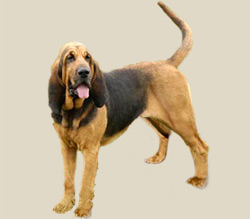
Country of Origin: Belgium, Great Brita
Group: Scenthounds and Related Breeds
Section: Scenthounds
Original Function: trailing
Todays Function: trailing humans, search and rescue
Dimension Male: 63-69 cm
Dimension Female: 58-63 cm
Weight Male: 41-50 kg
Weight Female: 36-45 kg
Litter Size: up to 15 puppies, average 8
Life span: 7-10 years
Other Names: Chien De Saint-Hubert, St. Hubert Hound, Flemish H
Colors: Black and tan, liver and tan, or red. the darker colors are sometimes interspersed with lighter or b
Living: While they can handle living in an apartment they love being couch potatoes,, it is best that they h
Recognized: CKC, FCI, AKC, UKC, KCGB, CKC, ANKC, NKC, NZKC, APRI, ACR
Description
The Bloodhound is a very powerful, massive hound with a long muzzle, drooping ears, and loose, wrinkled skin. His jowls and handing skin give the Bloodhound a rather mournful, dignified expression. The neck is very well muscled and has pendulous dewlap. Its back is extraordinarily strong for the dog"s size. Powerful shoulders allow the dog to work for long hours without a break. The forelegs are straight, solid and muscular and the skull is very high and prominent. The tail is carried in an elegant curve above the topline of the back. The eyes are set deeply in their sockets. The lower lids of the eyes fall away to reveal part of the inner surface. It has a black nose that sits on the tip of the long muzzle. The folds of the skin are said to aid in holding scent particles. A short, fairly hard coat of hair covers the body. The hair is softer on the skull and ears. The coat is easy to care for with a hound"s glove and comes in black & tan, liver & tan, and red & tawny.
Temperament
For all its calm manners at home, the bloodhound is a tireless trailer once on the track. It is tough, stubborn and independent, yet it is so gentle and placid that it is extremely trustworthy around children — although it may not be playful enough for some children"s needs. Nonetheless, it is not the lazy ol" hound dog portrayed in folklore but instead an active, playful companion. Although not the easiest breed to train for traditional obedience, it is exceptionally easy to train in tasks involving trailing. The bloodhound is reserved with strangers.
Excercise
As a hunting hound, the bloodhound needs a good deal of daily exercise. It was bred to trail through any hardship, and once on a trail it cannot be called off. It thus must be exercised in a safe area. The bloodhound drools a lot, so its facial wrinkles require daily cleaning; the ear tips drag in food and must also be kept clean. The ear canals also need regular cleaning for good health. Coat care is minimal, requiring only occasional brushing or wiping. Bloodhounds can live outside in temperate climates if they are given plenty of shelter and soft, warm bedding. Most do best as indoor/outdoor dogs; note, however, that this is not the breed for people obsessed with cleanliness in the house!
Grooming
The smooth, shorthaired coat is easy to groom. Groom with a hound glove, and bathe only when necessary. A rub with a rough towel or chamois will leave the coat gleaming. Clean the long, floppy ears regularly. Bloodhounds have a distinctive doggy odor, whi
Health
Major concerns: ectropion, entropion, gastric torsion, otitis externa, skin-fold dermatitis, CHD, elbow dysplasia
Minor concerns: none
Occasionally seen: none
Suggested tests: hip, elbow, eye
Click here to ORDER this PUPPY
